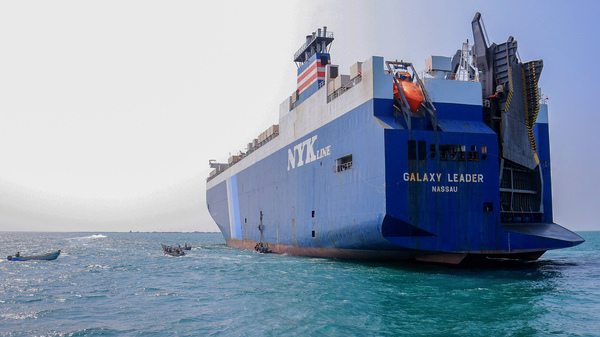
2023 was the worst year to buy a house since the 1990s. But there's hope for 2024
January 19, 2024
TikTok cuts jobs as tech layoffs continue to mount
January 23, 2024An upsurge in attacks on commercial ships by Iranian-backed Houthi rebels in the Red Sea threatens to disrupt the global supply chain as vessels are forced to reroute around Africa to avoid the conflict zone. Normally, about 15% of the world's trade passes through the Red Sea, and delays and escalating insurance costs are hitting industries such as petroleum, food and electronics.
Manufacturers have already experienced some problems in getting parts to assembly floors, and both Tesla and Volvo last week blamed the Red Sea troubles for delays at plants in Europe.
But shipping industry experts hope lessons learned during the COVID-19 pandemic, the Suez Canal disruption in 2021 and Somali pirate attacks more than a decade ago will help mitigate widespread problems this time, should the conflict widen in the Red Sea.
Since October, the Houthis have targeted several ships on the Red Sea with ballistic missiles and drones and have hijacked others near the entrance to the vital corridor at the Bab-el-Mandeb strait. The Houthis have said their attacks are in response to Israel's air and ground assault on Gaza, which has killed nearly 25,000 Palestinians, according to Gaza's Health Ministry. The military campaign in Gaza followed the Oct. 7 attack by Hamas that Israel says killed 1,200 people.
The U.S., leading a maritime coalition involving more than 20 countries, according to the Defense Department, has launched airstrikes against the Houthis to secure the waterway.
Supply chain disruptions are nothing new for the shipping industry. The COVID-19 pandemic presented an unprecedented challenge for the industry — with vessels stuck at ports waiting to load goods even as freight rates skyrocketed from a lack of capacity and quarantined consumers ordered everything online. Also in the Red Sea, the giant Ever Given container vessel became lodged in the Suez Canal in 2021, halting all traffic through that vital area for nearly a week. And more than a decade ago, Somali piracy was a major concern for shippers as well.
The Houthis present a more serious challenge, says Munro Anderson, head of operations at Vessel Protect, which specializes in marine war risk insurance. "It's unfortunately quite difficult to mitigate against drones, drone strikes, water-borne IEDs [improvised explosive devices] and things like that. So a number of the major lines have obviously decided to discontinue transits through the Red Sea and take the longer route."
So, what has the industry learned from these frequent disruptions that could contain the impact this time around?
The industry has gotten better at quickly assessing risk
The supply chain issues associated with COVID-19 did not come all at once. In fact, they reverberated in successive waves as the pandemic appeared to wax and wane over time. The pandemic, for example, made it difficult for automobile manufacturers to get parts to build cars. Lumber prices also skyrocketed as transportation networks were impaired by COVID-19 just as pandemic-related home renovations became more popular.
However, most experts believe the current situation won't be nearly as disruptive in the long run, although some think it could be months before the Houthi threat is eliminated.
Lisa Anderson, a supply chain expert and president of California-based LMA Consulting Group, says that in the past, shippers, vessel operators and manufacturers may have waited too long to properly evaluate an emerging threat such as COVID-19 or the Houthis, when taking action sooner would have been prudent.
This time around, companies seem to be moving more quickly, Anderson says. For example, Denmark-based Maersk and Germany's Hapag-Lloyd — two of the world's largest container lines — have already decided to reroute around South Africa to protect their crews, ships and cargo.
"We have to become comfortable with uncertainty," Anderson says. "No one wants to be, but that's the world we're living in."
Lars Jensen, CEO of Vespucci Maritime in Copenhagen, Denmark, says anticipating how a situation such as the Houthi threat will play out weeks and even months down the road is important for customers — those contracting to move goods and the shippers themselves. That extends to how costs will be passed on to consumers.
"It's the ability … to be able to sit down when you have some of these supply chain disruptions and not look at the immediate present, but to say, 'Well, what [kind of] domino effect will this cause three, four or five or six weeks down the line?'" Jensen says.
Lisa Anderson, who advises companies on supply chain management issues, says when a crisis such as the current one in the Red Sea arises, "You need to be asking, 'What are some backup plans that I can be putting in place now? Should I develop a relationship with additional suppliers? Should I find alternate routes? How much will it cost me to fly critical goods, let's say, or critical items to key customers or key manufacturers to keep their production going?'"
Some of those answers will be different depending on who is operating the ship, which country's flag the vessel flies, how old the ship is and what it's carrying, says Vessel Protect's Munro Anderson.
In the case of the Houthi attacks in the Red Sea, initially vessels with an Israeli affiliation were targeted. In recent weeks, U.S.-flagged ships and vessels affiliated with other nationalities have been targeted.
"There is definitely a waning appetite for underwriting risks in the Red Sea," Munro Anderson says.
He says that for large ship owners and operators such as Maersk, "I'd be fairly comfortable in saying that the risk to life at sea is probably the number one guiding principle."
Experts say it costs shippers an additional $1 million each way and nine to 12 more days at sea each way to travel the longer route around South Africa's Cape of Good Hope. That compares with $1 million to $1.5 million more for insurance to transit the Red Sea right now.
But "a good benchmark" for the value of a large container ship plus its cargo is about $1 billion, says Jensen, meaning that the additional costs for an "around Africa" route, while not insignificant, are worth it to avoid the risk of going through the Red Sea right now.
In fact, Egypt, which operates the Suez Canal, the northern terminus of the Red Sea route, reports a sharp drop in revenue from transit fees in recent weeks. The Suez Canal Authority's chairman, Adm. Osama Mounier Mohamed Rabie, said last week that revenue had fallen by 40% in the first 11 days of January.
Just-in-time inventories vs. just-in-case inventories
Basil Karatzas, the CEO of Karatzas Marine Advisors, says that COVID-19 has caused many manufacturers to add slack to their inventories to prepare for unexpected supply chain shocks. "Basically we have gone from a just-in-time inventory to just-in-case inventory," he says.
Some manufacturers, stung by massive disruptions during COVID-19, have also begun "reshoring," or bringing more of the process closer to consumers, LMA's Lisa Anderson says. In some cases, "they're coming back to the U.S., they're going to Mexico and they're going to Central and South America," she says.
She gives one of her customers as an example: a producer of lawn and garden products that saw a surge in sales in the U.S. during COVID-19. Production was based in China, which experienced a prolonged lockdown during the pandemic. "They ended up moving the bulk of their production to Mexico," she says.
Jensen acknowledges that some additional inventory and reshoring has been built into supply chains, but that without any major disruptions in 2023, "freight rates came tumbling down actually to even below pre-COVID levels."
"And what did all these importers do? Or at least a large part of them? They went back to just-in-time logistics," he says. "So, the lessons during the pandemic that you should have a more resilient supply chain — that also went out the window last year."
Lots of new ships were built during the pandemic. That means plenty of spare capacity
During the pandemic, when freight rates were sky-high, the container-shipping industry ordered a large number of ships to be built, Jensen says. A lot of those vessels are coming out of shipyards now. Before the Houthi trouble, that resulted in tumbling freight rates. Last year, "they already had overcapacity," he says. "And 2024 was going to have even more overcapacity."
Jensen says that before the Houthi crisis, "shipping lines were basically back to being loss-making" as a result of this overcapacity. But now this may be changing, he says.
"Now we've gotten to a point where we have enough capacity, but only just," he says. "That has caused freight rates to go up dramatically over the last five weeks." Still, he says, "we are nowhere near the freight-rate levels we saw during the pandemic."
As a comparison, Jensen says, "If you look at the spot rate right now from Asia into, for example, [the] U.S. East Coast, I believe we are now looking at something to the tune of about $5,000." The extreme rates during the pandemic were up to five times higher, he says.
Vessel Protect's Munro Anderson says it's too early to know exactly how long the disruptions will continue. "We are still in the midst of these tit-for-tat strikes," he says. "This has yet to play out."
Instead, those vessel operators willing to brave the Red Sea will have to depend on the U.S.-led maritime coalition for protection, Karatzas says. "But the minute you get an attack by a drone, no commercial vessel is prepared or can be prepared to address that."
Ultimately, a military response alone will probably not be enough, says Munro Anderson. A real solution, he says, "lies in the diplomatic resolution of the issues that are faced in that region."
"That is what the market would like to see," he says.
Copyright 2024 NPR. To see more, visit https://www.npr.org.





